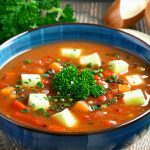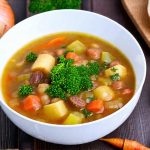The chill in the air often beckons us toward warm, comforting foods – hearty stews, creamy soups, baked goods brimming with spice. For many, these are simple pleasures, but for those navigating gut issues like Irritable Bowel Syndrome (IBS), Crohn’s disease, or sensitivities to certain foods, that same comfort can quickly turn into discomfort. The challenge isn’t necessarily avoiding all comforting meals during cold weather; it’s about thoughtfully adapting them to support digestive health and minimize symptoms. Finding the right balance between satisfying cravings and respecting your gut requires understanding how different ingredients affect your body and learning to make informed choices that nourish both mind and body.
The good news is, a warming meal doesn’t have to exacerbate gut problems. In fact, nourishing foods can be incredibly soothing during times when you’re feeling physically vulnerable due to illness or cold weather. This article will explore strategies for creating comforting meals specifically designed with digestive health in mind, focusing on ingredients and preparation methods that prioritize gentleness and ease digestion. We’ll move beyond restrictive diets and delve into how to enjoy flavorful, satisfying food without compromising your well-being – even when the temperature drops. The key lies in understanding the connection between what we eat, our gut microbiome, and how these factors impact overall comfort and health. For those seeking a more targeted approach, consider exploring micronutrient panels for people to identify specific deficiencies.
Gentle Soups & Stews: Building Blocks of Comfort
Soups and stews are quintessential cold-weather fare for a reason; they’re warming, hydrating, and often easy to digest. However, traditional recipes can include ingredients that trigger gut issues – excessive onions, garlic, spicy seasonings, or high-FODMAP vegetables. The trick is adapting these classics with mindful substitutions and careful preparation. Using a base of bone broth (or a well-tolerated vegetable broth) provides collagen and amino acids known to support gut lining health. Lean proteins like chicken or turkey are easier on the digestive system than red meat, and well-cooked vegetables are generally better tolerated than raw ones.
When constructing your soup or stew, prioritize low-FODMAP options when possible. Carrots, potatoes (especially sweet potatoes), spinach, and zucchini are often well-tolerated choices. Avoid or limit high-FODMAP ingredients like onions, garlic, broccoli, cauliflower, apples, pears, and wheat-based thickeners. Instead, use herbs like thyme, rosemary, and ginger for flavor – these can offer anti-inflammatory benefits too! Consider using a small amount of butternut squash as it tends to be lower in FODMAPs than other squashes. The goal is not deprivation, but rather finding ingredients that allow you to enjoy a comforting meal without triggering symptoms. If planning meals is proving difficult, remember there are low-effort meals for days when energy levels are low.
Finally, the cooking method matters. Slow cooking or gentle simmering breaks down fibers and makes vegetables easier to digest. Avoid frying or using excessive amounts of oil, as these can sometimes exacerbate digestive distress. A creamy texture doesn’t necessarily mean dairy – pureed sweet potato or blended cauliflower can create a wonderfully rich and satisfying consistency without the potential issues associated with lactose intolerance or dairy sensitivities. Remember to portion control; even healthy foods can cause problems if consumed in excess. If you are recovering from a flare, comfort meals for recovery can be extra supportive.
Navigating FODMAPs: A Quick Guide
FODMAPs (Fermentable Oligosaccharides, Disaccharides, Monosaccharides And Polyols) are short-chain carbohydrates that some people have difficulty digesting. This can lead to gas, bloating, and other digestive symptoms. Understanding which foods fall into the high-FODMAP category is crucial for tailoring your meals.
- High FODMAP Foods (Examples): Onions, garlic, apples, pears, wheat, dairy products containing lactose, beans, lentils, honey.
- Low FODMAP Foods (Examples): Carrots, potatoes, spinach, zucchini, rice, oats, lactose-free milk alternatives, bananas, blueberries.
It’s important to note that tolerance levels vary greatly from person to person. What triggers symptoms for one individual may not affect another. A low-FODMAP diet is often used as a temporary elimination diet to identify trigger foods, guided by a healthcare professional. There are many excellent resources available online and through registered dietitians specializing in gut health that can help you navigate the complexities of FODMAPs. For those with lactose sensitivity, exploring fermented non-dairy options may provide relief and beneficial probiotics.
The Power of Ginger & Turmeric
Ginger and turmeric are two spices with remarkable anti-inflammatory properties, making them valuable additions to meals for those with gut issues. Inflammation is often a key component of many digestive disorders, so incorporating these spices can potentially offer relief. Ginger is known to soothe nausea and aid digestion, while turmeric contains curcumin, which has potent antioxidant and anti-inflammatory effects.
- Incorporate fresh ginger into your soups and stews – grated or thinly sliced adds a wonderful flavor boost.
- Turmeric can be added as a spice during cooking or consumed in golden milk (a warm beverage made with turmeric, plant-based milk, and spices).
- Be mindful that combining these spices with black pepper enhances curcumin absorption.
However, even these beneficial spices should be introduced gradually and monitored for tolerance. Some individuals may find that large amounts of ginger can exacerbate heartburn or acid reflux. Start with small quantities and observe how your body responds. To support overall wellbeing during uncomfortable times, gut rest techniques can provide much needed relief.
Bone Broth: A Gut-Healing Elixir
Bone broth isn’t just a trendy health food; it’s a traditional remedy that has stood the test of time. Made by simmering animal bones (typically chicken, beef, or fish) for an extended period, bone broth is rich in collagen, amino acids, and minerals. Collagen supports the integrity of the gut lining, potentially helping to reduce inflammation and improve digestion.
- Choose high-quality bones: Opt for organic, pasture-raised bones whenever possible.
- Simmer slowly: A longer simmering time (8-24 hours) extracts more nutrients from the bones.
- Add vegetables & herbs: Enhance flavor and nutritional value by adding carrots, celery, onions (if tolerated), garlic (if tolerated), ginger, and herbs like thyme or rosemary.
Even if you don’t want to make your own bone broth, commercially available options are readily available. Look for brands that are made from high-quality ingredients and have minimal additives. Sipping on a warm cup of bone broth can be incredibly soothing during cold weather – both for the body and the mind. If traveling, remember tips for eating while traveling to maintain digestive health even on the go.


















